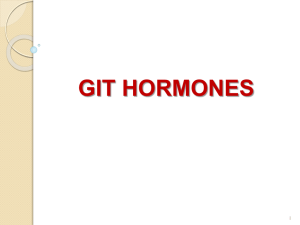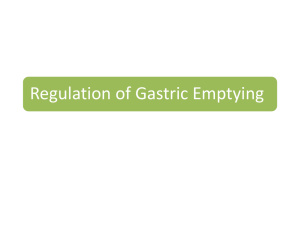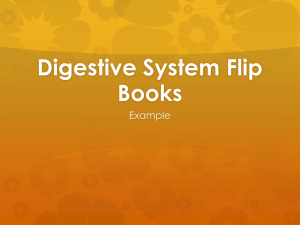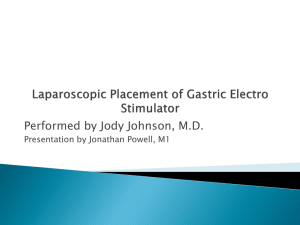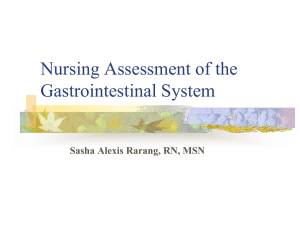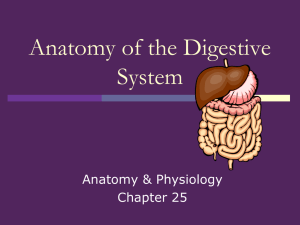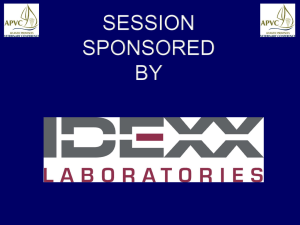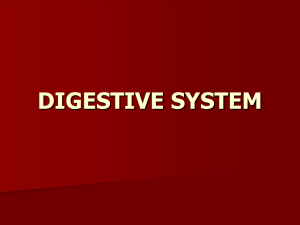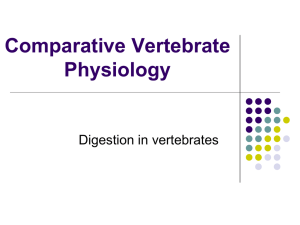Motor function of stomach
advertisement
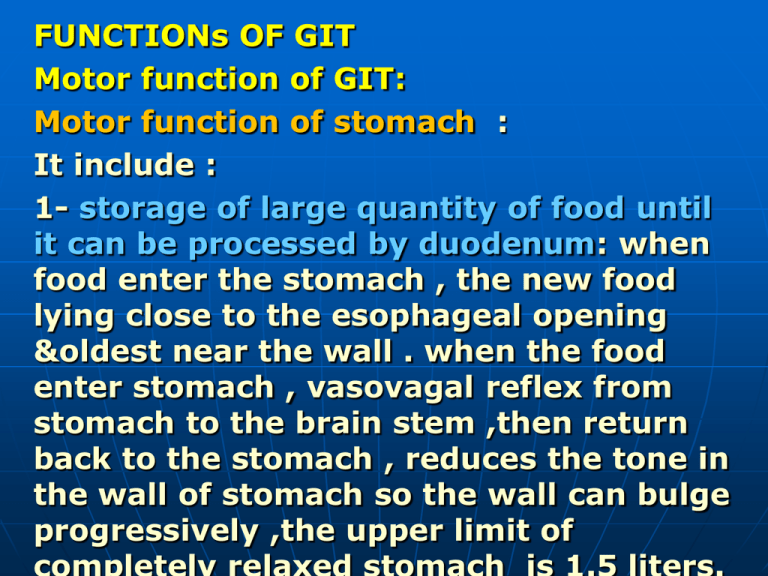
FUNCTIONs OF GIT Motor function of GIT: Motor function of stomach : It include : 1- storage of large quantity of food until it can be processed by duodenum: when food enter the stomach , the new food lying close to the esophageal opening &oldest near the wall . when the food enter stomach , vasovagal reflex from stomach to the brain stem ,then return back to the stomach , reduces the tone in the wall of stomach so the wall can bulge progressively ,the upper limit of 2- mixing of food with gastric secretion :the digestive juice of stomach secreted by gastric glands (cover almost the entire wall of stomach except the lesser curvature), when stomach contain food a constricter waves (mixing wave) begin in mid portion of stomach toward the antrum , once every 15 – 2o seconds , these waves limitted by basic electrical rhythm ( a slow wave occure spontaneously in the wall), the constricter waves become more tense as they progress from the body to the antrum & play important role in mixing the contents of stomach . after the food mixed with stomach secretion the resulting mixture that passes down the gut called chyme. 3- emptying of the stomach : This promoted by intense peristaltic contraction of antum & opposed by varying degree of resistance to the passage of the chyme at the pylorus. Regulation of stomach emptying : The emptying regulated by signals from both stomach &duodenum, the duodenum provide the more potent signals for emptying control. The weak gastric factors that promote emptying: 1-increased food volume in stomach promot increase gastric emptying. 2-effect of gastrin hormone which is realsed from antral mucosa in response to the prescence of certein foods in the stomach ,this hormone increase gastric acid secretion , it has stimulatory effect on motor function of stomach , it enhance the activity of pylorus The powerful duodenal factors that inhibit emptying : 1- gastroenteric reflex from the duodenum to the stomach to inhibit emptying . 2-hormonal feedback from duodenum inhibit gastric emptying ; fatty food in the duodenum cause the release of different hormones either by binding to receptores or other ways ,these carried by blolod to the stomach & then inhibit gastric emptying by inhibitting the pyloric pump or incresing the strength of pyloric contraction . Movements of S.I.: Mixing contraction (segmentation contraction):when the wall of the intestine strerched by chyme, it elicit localised concentric contraction spaced along the intestine ,the length of contraction is 1cm so that each set of contraction cause segmentation of S.I.,when segmentation contraction relax anew one begins, but the contraction this time occur in points between the previous contractions .the maximum frequency of this segmentation contraction in the upper S.I is 12 per minute, it become weak when the excitatory activity of enterric systerm blocked by atropin. Propulsive movement of S.I Peristalsis in S.I: -occure in any par of SI. -more faster in proximal than terminal intestine. Secretory function of GIT: Types of glands: several types of glands provide the GIT with different secretions : 1-on the surface of most part of GIT a large number of mucous glands called mucous cells or goblet cells .they function in response to local stimulation 2- many surface area of GIT are lined by pits Called crypts of leiberkih in S.I. 3- in stomach & upper duodenum a large number of deep tubular glands 4-several complex glands : salivary g., : pancreas, &liver. Basic mechanism of stimulation of GIT glands - Effect of food :presence of food in one segment of GIT,cause the glands of that portion &the adjacent to secrete digestive juice. -Epithelial stimulation activate the enteric nervous system , the types of stimuli are 1-tactile 2- chemical irritation 3-distention of gut wall. - Autonomic stimulation of secretion Parasympathetic nerve :it increase rate of secretion especially in the upper part of tract. Sympathetic stimulation cause slight increase of gland secretion .
